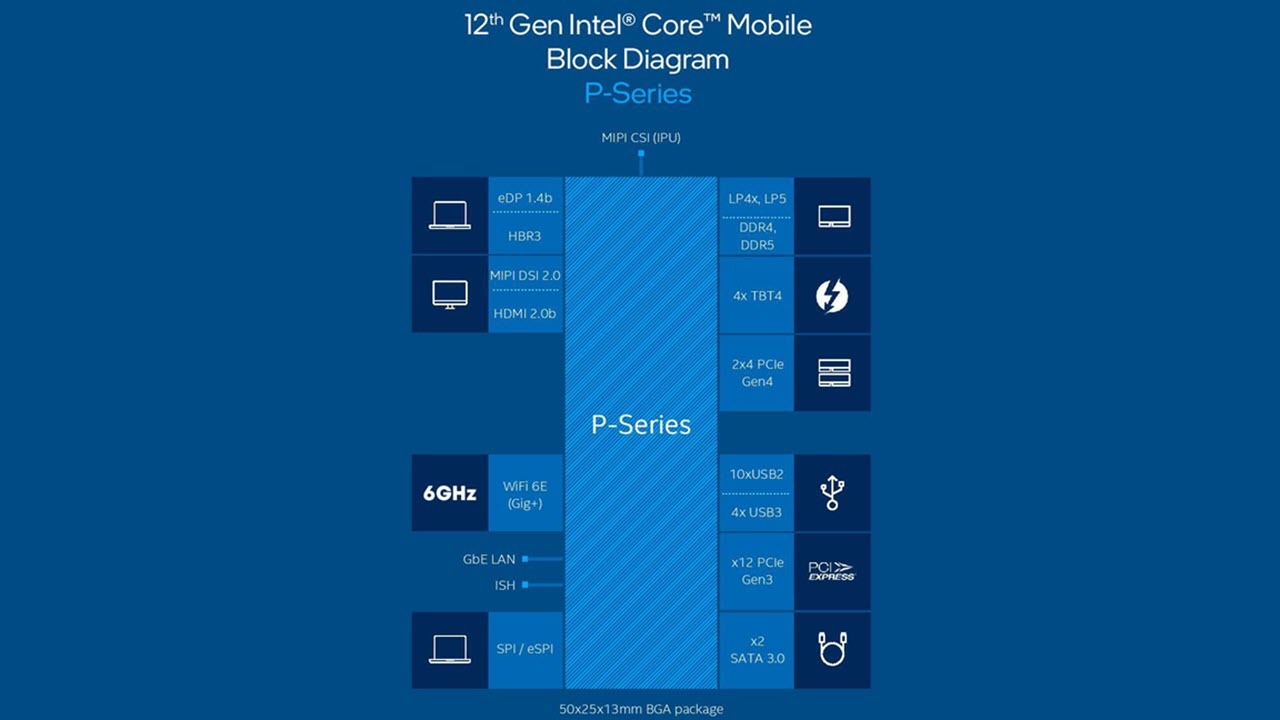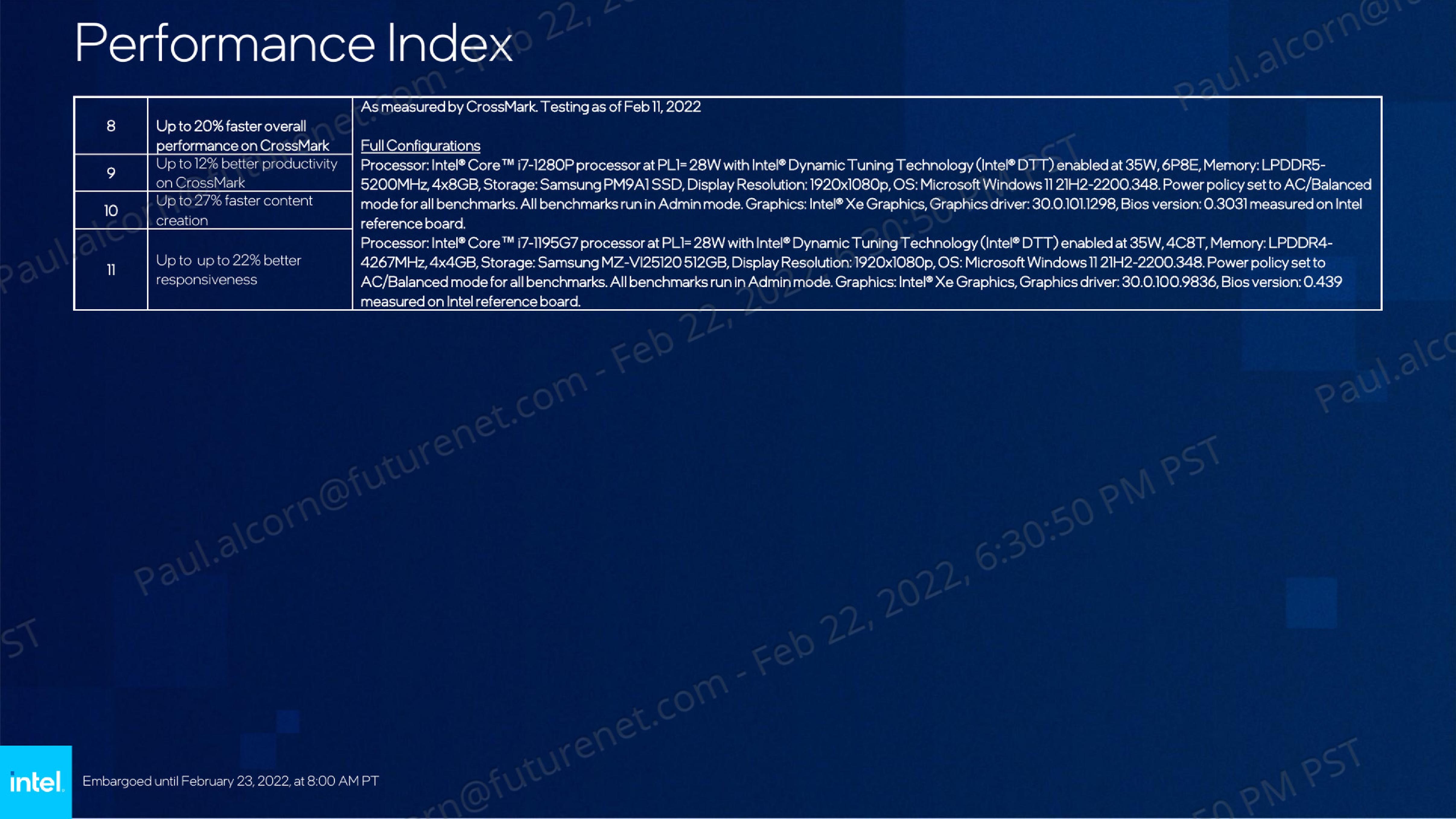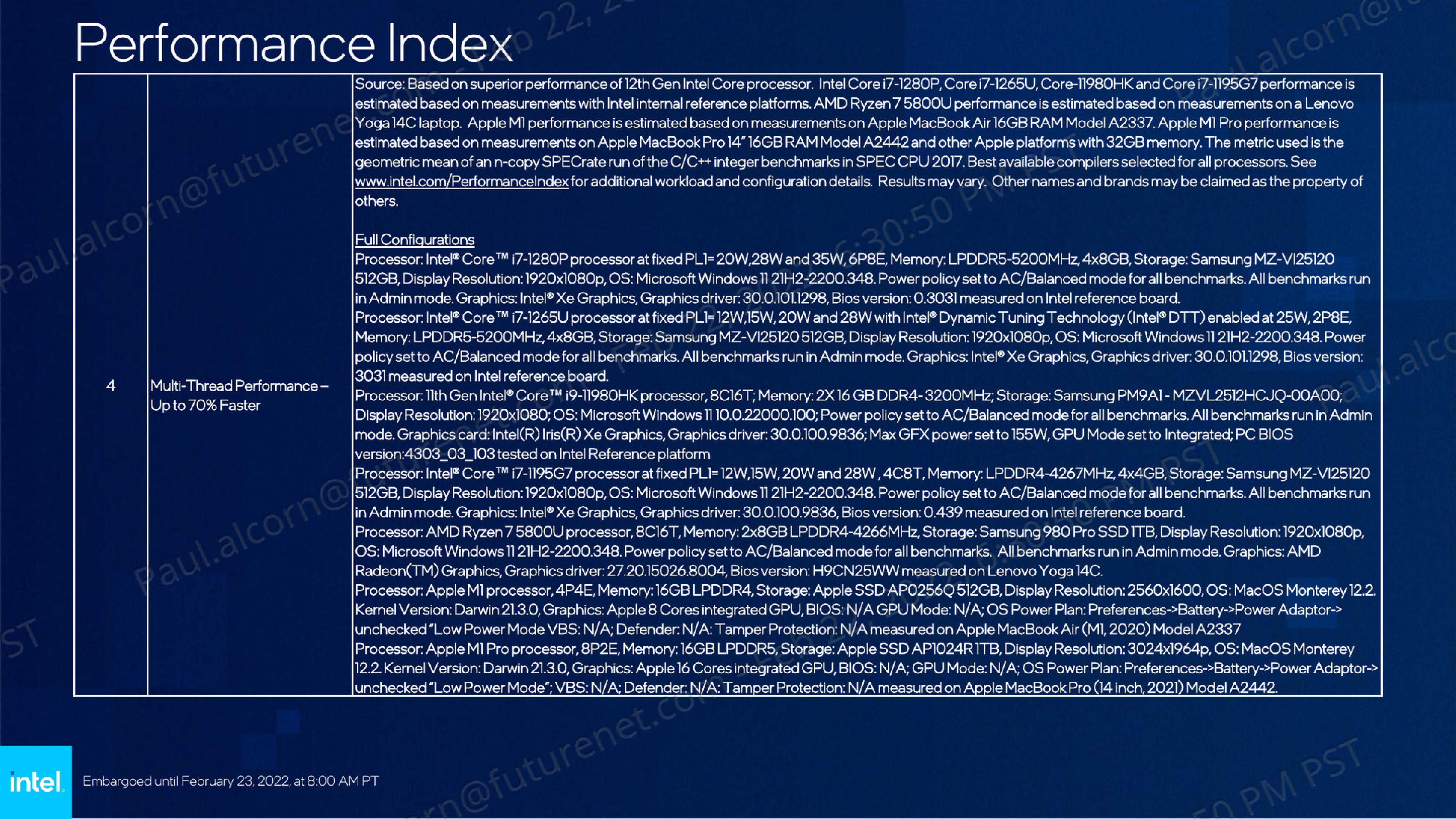Intel Details 12th-Gen Alder Lake U- and P-Series, up to 14 Cores at 28W
Intel announced the details of its new P-series 28W family of chips and its U-series Alder Lake processors today. Overall, Intel's new processors span from a five-core 9W chip up to a 14-core 28W flagship. These 20 new chips will debut in the first designs arriving in March, and Intel expects more than 250 designs to come to market eventually.
Intel launched its flagship 45W H-series Alder Lake Mobile processors at CES 2022, and we've seen those high-power chips take the lead in performance benchmarks over AMD's Ryzen and Apple's M1 chips. However, they still lag AMD and Apple in battery power life tests by significant margins. That's expected given the different target markets — AMD's recently-launched Ryzen 6000 Rembrandt processors aim for a blend of both performance and power efficiency in a more mainstream 35W power envelope, while Intel's inaugural 45W Alder Lake chips are tuned for high-end performance at all costs. When Intel's P- and U-series chips arrive, they'll give us a better idea of the competitive mobile landscape for the next year.
Intel already revealed the basics of its P- and U-series lineups at CES 2022, but it didn't share much information beyond the list of product SKUs. Today we learn some of the finer-grained details about the product families and also see some of Intel's performance claims, which includes up to a 70% improvement over its previous-gen Tiger Lake in multi-threaded work (at the same power level).
Like the rest of the Alder Lake lineup, Intel's P- and U-series leverage a hybrid x86 architecture with a mix of small and large cores. They also support leading-edge I/O, with support for four types of memory interfaces (DDR5, LPDDR5, DDR4, and LPDDR4x), along with PCIe 4.0 and a whole host of other connectivity options. Let's dive in.
Intel Clears up Some of the cTDP Branding Mess
Intel's new lineup helps clear up a lingering issue with Intel's product branding. Intel has long endured criticism for its practices surrounding its configurable TDP (cTDP) feature. This feature allows a single chip to operate in a wide power range, meaning it could have different levels of performance based on the settings used. For instance, the previous-gen Tiger Lake U-series chips can operate from a 12W to 28W TDP, and the Y-series chips can range from 7 to 15W.
The problem here is that Intel doesn't require vendors to divulge which cTDP they assign to a chip. For instance, you could buy a U-series model that runs at either 12W or 28W, but because there isn't a steadfast rule that requires OEMs to disclose the TDP settings on their packaging or in the marketing materials, you often won't know the actual performance range of the chip. As an example of what can happen to performance, we tested the Core i7-1065G7 in both 15W and 25W configurations, and in games the 25W mode was on average 35% faster.
The new P-series lineup helps clear this up because the 28W chips now have their own P-series swim lane. Intel assigns a 28W base power level, meaning you're assured that level of performance at a minimum, and as with all of its chips, also assigns a Max Turbo Power that indicates peak power consumption.
Meanwhile, the U-series models have 9W and 15W models, with the two split up into two separate packages that we'll cover below. You can distinguish between these two models based on the product naming convention (9W ends with '0,' while 15W ends with '5'), which also now allows you to determine the actual power usage of the chip.
All in all, this seems to be a positive change that could help clear up the confusion — if Intel sticks with it through multiple generations. The last generation found the company attempting to re-brand Y-series as UP3 and U-series as UP4, both with a dynamic range of TDPs. The company also used confusing G7, G4, and G1 suffixes to communicate the graphics capabilities of its previous-gen mobile chips, but thankfully it has discarded that nomenclature with Alder Lake, too.
Intel 12th-Gen Core Alder Lake P- and U-Series
Intel's 12th-Gen Alder Lake chips feature the company's hybrid x86 architecture, which combines big and fast Performance cores (P-cores) with clusters of small and powerful Efficiency cores (E-cores) that chew through background processes. As a result, these chips will run best with Windows 11 due to its Thread Director technology (Intel says the majority of devices will ship with Win11). You can read more about the architecture here.
Get Tom's Hardware's best news and in-depth reviews, straight to your inbox.
Intel says that its new Alder Lake models provide 9+ hours of battery life, but that is the same as its spec for its last-gen chips. Intel says this is because it has intensified the workload it uses to measure battery life by adding Bluetooth headset usage and more intense background workloads to its battery life workload.
As you would expect, AMD claims that its Ryzen 6000 chips have better performance, performance-per-watt, and battery life than Intel's Alder Lake. AMD claims 24 hours of battery life, but it is notable that AMD and Intel use very different methodologies for battery life claims — AMD tests in airplane mode with the panel brightness tuned to 100 nits while playing video only. Intel claims it could match that 24-hour rating under the same conditions, but doesn't measure under the same conditions because it doesn't think it's applicable to most users.

The P-series is designed to bring higher levels of threaded performance to the thin-and-light category for heavy tasks like encoding and rendering, while still being snappy in lightly-threaded work, like web browsers and office tasks. Intel assigns a 28W processor base power and 64W max turbo power for the entire P-series lineup. All of these chips come with a 'P' suffix.
The P-series tops out with the 14-core 20-thread Core i7-1280P. This chip comes with six P-cores and eight E-cores, with both signifying the max core count for the Core i7 series. The chip operates at a 1.8 GHz base and 4.8 GHz boost on the P-cores, while the E-cores range from 1.3 to 3.6 GHz.
You'll also notice that the Core i7 lineup also includes two models with 12 cores and 16 threads (four p-cores and eight e-cores), and you'll find the same core counts on the Core i5 models — clock speeds, L3 cache capacity, and the integrated GPU make up the primary difference between the two lineups. Finally, the Core i3 steps in with ten cores and 12 threads (two P-cores and eight E-cores).
The P-series chips come with the same Intel Iris Xe graphics engine found on the previous-gen Tiger Lake models, with 96EU at 1.4 to 1.45 GHz for Core i7, 80EU at 1.3 to 1.4 GHz for Core i5, and 64EU at 1.1 GHz for the lone Core i3 chip.

The 15W U-series chips come with a 15W base power, 55W max turbo power rating, and a 'U' suffix for the product name. These chips also have a '5' at the end of the product number to signify they are 15W models. These chips are designed for mainstream audiences, so they'll represent the bulk of Intel's laptop sales.
The U-series 15W Core i7 and Core i5 models all come with ten cores and 12 threads (two P-cores and eight E-cores) along with 12MB of L3 cache. CPU clock speeds and iGPU EU counts/frequencies delineate the two categories (96EU at 1.25 GHz for Core i7, 80EU at 1.2 GHz for Core i5).
Core i3 steps in with six cores and eight threads, courtesy of two P-cores and four E-cores. Intel reduces the L3 cache to 10MB, a natural byproduct of the reduced number of E-cores, while the GPU has been trimmed to 64EU at 1.1 GHz.
Intel also has 15W Pentium and Celeron chips, with both armed with five cores (one P-core and four E-cores), 8MB of L3 cache, and 48-EU iGPUs that run at up to 1.1 GHz. Oddly enough, Intel disabled threading on the Celeron's P-core to reduce its thread count to five (Pentium has six) and also cut support for turbo boost. Surprisingly given the drastically reduced core counts, Intel still assigns a 15W/55W power rating to these lowest-end models.

The lower end of Intel's Alder Lake mobile lineup consists of the 9W models with an '0' suffix. These chips all come with a 9W base power and 29W max turbo power rating. These chips come with similar core counts and L3 cache capacities as the 15W models but feature a lower peak power rating of 29W (compared to 55W). As expected, this results in lower base frequencies across the entire lineup. Intel also reduced the iGPU frequencies significantly.


Intel's Alder Lake mobile chips compete with AMD's Ryzen 6000 'Rembrandt' processors, which you can see in the slides above. You can learn more about those chips here.
Above, we can see the HS-series models that come to market with the first wave, along with the HX- and U-series models that also arrive in March. AMD has carved these into three swim lanes based on device form factor/thickness. Notably, the last slide shows the three refreshed Ryzen 5000 'Cezanne' models included in the Ryzen 6000 family (bottom of the table).







Intel’s entire Alder Lake platform supports four different types of memory (DDR5/LPDDR5/DDR4/LPDDR4x), with LP/DDR4 memory stepping in for lower-cost mobile devices.
The H-, P- and 15W U-series chips ride on a pin-compatible 50x25mm BGA package, giving OEMs the flexibility to drop in different classes of processors in their designs without extensive redesigns (this should be most common with P- and 15W U-series chips, though). The 9W U-series chip features a 28.5x19x11mm BGA package.
All Alder Lake Mobile chips come with the PCH on the same package to help reduce complexity and provide incremental power savings, but the different swim lanes offer varying connectivity options. For instance, the P- and 15W U-series drop the x8 PCIe 4.0 connection for an external graphics card because most models will use integrated graphics. (Intel says some P-series models might come with a discrete GPU, but they will be rare). However, the chips still offer a x12 PCIe 3.0 connection via the chipset, and all other connectivity options remain the same.
The 9W U-series has some additional reductions, with only two 40 Gbps Thunderbolt 4 connections, one PCIe x4 connection for storage, six USB2 connections, x10 PCIe 3.0, and no SATA connectivity.
As before, Intel has integrated the digital portion of its Wi-Fi 6E (Gig+) connection directly into the chip, while the RF companion module connects externally.





Intel shared some of its own internally-run benchmarks as part of its materials, but as with all vendor-provided performance data, you should take it with plenty of salt. The test notes are at the end of the article.
Intel used Spec_rate n-copy 2017 to generate the first chart with power level 1 (PL1) plotted along the bottom of the chart while the vertical axis plots relative performance. Intel shows Alder Lake and Tiger Lake performance across a wide range of power envelopes but says it couldn't alter the power range of competing chips. As such, it only provides one measurement for the AMD and Apple models. Additionally, Intel did not have any Ryzen 6000 models for comparison as they aren't available yet.
Intel claims the P-series' multi-threaded performance is 70% faster than the Tiger Lake i7-1195G7 at 28W and that the U-series is also 30% faster than Tiger Lake at the same 28W. Notably, Intel's 70% faster claim is relative to its own chips, not AMD and Apple.
Intel also shared a broader spate of common benchmarks, including Blender to quantify threaded performance, and WebXPRT 4 (browser) and PugetBench for Photoshop to measure performance in lightly-threaded work. Finally, the cross-platform Crossmark steps in for a wider range of workloads, but this benchmark is a bit obtuse with its generic results categories. Again, Intel has competing AMD and Apple chips in the chart for all of these tests, but the percentage values are relative to its Tiger Lake CPU.
Alder Lake Mobile's graphics engine is the same as found in the Tiger Lake mobile products, so you shouldn't expect any big improvements here. Intel claims that the iGPU can support 1080P gaming at both medium and high settings.
We won't spend too much time analyzing these performance claims — we prefer to run our own tests. Intel says the first Alder Lake mobile models are in production now and will come to market in March, which is also in the same time frame as the competing Ryzen 6000 models. As you would imagine, we'll have devices in our labs. Stay tuned.






- MORE: Best CPUs for Gaming
- MORE: CPU Benchmark Hierarchy
- MORE: AMD vs Intel
- MORE: All CPUs Content

Paul Alcorn is the Editor-in-Chief for Tom's Hardware US. He also writes news and reviews on CPUs, storage, and enterprise hardware.
-
salgado18 ReplyAs you would expect, AMD claims that its Ryzen 6000 chips have better performance, performance-per-watt, and battery life than Intel's Alder Lake. AMD claims 24 hours of battery life, but it is notable that AMD and Intel use very different methodologies for battery life claims — AMD tests in airplane mode with the panel brightness tuned to 100 nits while playing video only. Intel claims it could match that 24-hour rating under the same conditions, but doesn't measure under the same conditions because it doesn't think it's applicable to most users.
That depends a lot, I'm divided here. On one side, AMD is right, as it isolates their processor and system, and should show how much the CPU and GPU consume alone. On the other hand, I believe most users would use an unplugged notebook with some sort of internet connection. But even then, it's fair to expect a lower brightness setting in this situation. I think Intel is just running from the fight, if they insist on letting other parts of the system to use a lot of energy to make their numbers look less bad.
Well, better to wait for independent reviews anyway. -
shady28 Honestly CPU vendor measures (AMD and Intel) of battery life are pretty irrelevant. If you are building your own box from components then there are reviews that isolate the CPU if you are really interested in power \ performance ratios, but with a laptop it's impossible to isolate the CPU from the motherboard / chipset / display / memory and so on.Reply
You might get a general idea for how a laptop with X CPU will perform and how long its battery life will be, but in the real world all those other factors will come into play. I would always compare laptop vs laptop, not laptop cpu vs laptop cpu. -
FakeMike Reply
Well, sure but when comparing and buying laptops the CPU is usually the first thing to consider as it determines not only the general use case (everyday, gaming etc) but also other features (connectivity etc).shady28 said:Honestly CPU vendor measures (AMD and Intel) of battery life are pretty irrelevant. If you are building your own box from components then there are reviews that isolate the CPU if you are really interested in power \ performance ratios, but with a laptop it's impossible to isolate the CPU from the motherboard / chipset / display / memory and so on.
You might get a general idea for how a laptop with X CPU will perform and how long its battery life will be, but in the real world all those other factors will come into play. I would always compare laptop vs laptop, not laptop cpu vs laptop cpu. -
watzupken As expected, the max power draw for boost is very high @ 64W, when we consider the fact that most of these CPUs have a 15W TDP. That is 4x higher to obtain the boost clockspeed. In real life usage, I think the battery life under light usage will decent because I suspect Intel will offload most if not all the work to the E-cores. But when you are gaming or loading the system where the P-core wakes up, then I believe battery life will take a hit when compared to Ryzen 6000 series. Otherwise, I expect heavy throttling due to heat and/or power limit.Reply -
shady28 ReplyFakeMike said:Well, sure but when comparing and buying laptops the CPU is usually the first thing to consider as it determines not only the general use case (everyday, gaming etc) but also other features (connectivity etc).
Not really. For many the display quality, keyboard, and trackpad are far more important than if their Excel spreadsheet recalculates in 3.2s instead of 3.4s. Battery life is actually the #1 thing that users used to say, though I think that distinction is becoming less in the thin and light area (once you go over 10-11 hours, it's not as important IMO). If you actually use a laptop for work, you'd know this.